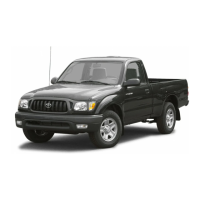’04 MATRIX_U (L/O 0307)
267
2004 MATRIX from Oct. ’03 Prod. (OM12861U)
High tire pressure (overinfla-
tion)—
# Poor handling
# Excessive wear
# Uneven wear
# A greater possibility of tire
damage from road hazards
Tread wear indicator
CHECKING YOUR TIRES
Check the tires tread for the tread
wear indicators. If the indicators
show, replace the tires. The loca-
tion of the tread wear indicators is
shown by the “TWI” or “
∆” marks,
etc., molded on the sidewall of
each tire.
The tires on your Toyota have built−in
tread wear indicators to help you
know when the tires need replace-
ment. When the tread depth wears to
1.6 mm (0.06 in.) or less, the indica-
tors will appear. If you can see the
indicators in two or more adjacent
grooves, the tire should be replaced.
The lower the tread, the higher the
risk of skidding.
Vehicles equipped with
P215/50ZR17 tires: Your Toyota has
been fitted with specially developed
tires which provide exceptional dy-
namic performance under general
road conditions. However your riding
comfort may worsen a little and road
noise may increase during driving.
You may also notice that your tires
will wear more rapidly and tire grip
performance will be reduced on the
snowy and/or icy roads when
compared to standard tires. Be sure
to have snow tires or tire chains on
the snowy and/or icy roads and drive
carefully with the speed appropriate
for road conditions.
Checking and replacing tires
